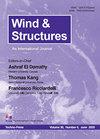Paiva河上516 Arouca行人悬索桥的空气动力学特性
IF 1.9
4区 工程技术
Q3 CONSTRUCTION & BUILDING TECHNOLOGY
引用次数: 0
摘要
考虑到516 Arouca行人悬索桥的设计和特点,业主(市政当局)要求进行一系列测试,以评估其空气动力学特性和动态响应,旨在同时满足结构安全性和用户舒适度。在截面比例模型上进行了风洞试验,获得了静力气动系数和动力响应。测试是在不同的桥梁结构上进行的——一个甲板上有人,一个甲板上有一个拱形的副索(连接每个悬挂点到甲板对面的悬链线)——用于静力系数。对于动力响应,仅对甲板进行了单独测试。由于主要的位移模式属于摆动运动,因此必须克服一个重大挑战,以组装风洞设置,需要一个允许风位移的悬挂系统。确定了小振幅位移的持续趋势,影响用户舒适度并有助于安装二次电缆,但未确定空气动力学不稳定性。本文章由计算机程序翻译,如有差异,请以英文原文为准。
Aerodynamic Characterization of the 516 Arouca Pedestrian Suspension Bridge over the Paiva River
Given the 516 Arouca pedestrian suspension bridge’s design and characteristics, the owner, a municipality, required a set of tests in order to evaluate its aerodynamic characteristics and dynamic response, aiming at both structural safety and user comfort. Wind tunnel tests were performed over a sectional scaled model to obtain the static aerodynamic coefficients and dynamic response. The tests were carried out on different bridge configurations—a deck with people and a deck with an arch for secondary cables (connecting each suspension point to the catenary on the opposite side of the deck)—for the static coefficients. For the dynamic response, only the deck alone was tested. A major challenge had to be overcome, as the main displacement mode belonged to a swing movement, to assemble a wind tunnel setting, requiring a suspension system allowing wind displacements. A persistent trend of small amplitude displacements was identified, influencing user comfort and contributing to the installation of the secondary cables, but no aerodynamic instabilities were identified.
求助全文
通过发布文献求助,成功后即可免费获取论文全文。
去求助
来源期刊

Wind and Structures
工程技术-工程:土木
CiteScore
2.70
自引率
18.80%
发文量
0
审稿时长
>12 weeks
期刊介绍:
The WIND AND STRUCTURES, An International Journal, aims at: - Major publication channel for research in the general area of wind and structural engineering, - Wider distribution at more affordable subscription rates; - Faster reviewing and publication for manuscripts submitted.
The main theme of the Journal is the wind effects on structures. Areas covered by the journal include:
Wind loads and structural response,
Bluff-body aerodynamics,
Computational method,
Wind tunnel modeling,
Local wind environment,
Codes and regulations,
Wind effects on large scale structures.
 求助内容:
求助内容: 应助结果提醒方式:
应助结果提醒方式:


